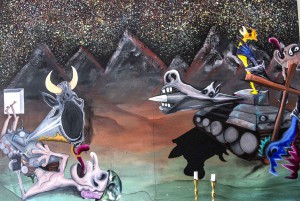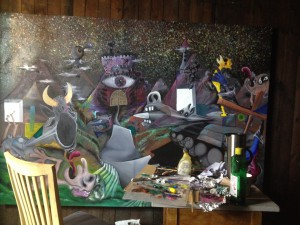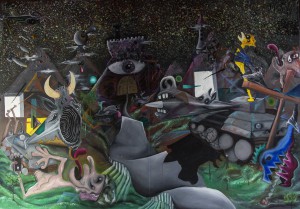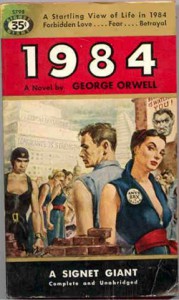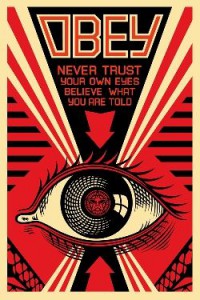What is art? The art establishment has an all-inclusive answer: anything is art if a reputed artist or museum expert says it is (the institutional concept of art – invented by George Dickies). Yes, but is it art? Today I will boldly go, where thousands have gone before me! I will cross this minefield in pursuit of an answer to the ever emerging question. What is art? Most generalisations are false, but they can give some charity and movement towards answering this fluid question. And believe it! I will come to a valid answer.
A call to objectivism: Know your urinal?
[su_quote]To evoke in oneself a feeling one has experienced, and…then, by means of movements, lines, colors, sounds or forms expressed in words, so to transmit that feeling—this is the activity of art.[/su_quote] – Leo Tolstoy (1828–1910)
I started reading philosopher-novelist Ayn Rand (1905-1982). Best known as the author of The Fountainhead and Atlas Shrugged´s. She´s objectively a mad bitch, but still let us try to give her objectivism a chance. Ayn Rand also has a “groundbreaking” alternative view on what art is. It’s an original and illuminating theory of art, which confirms the widespread view that much of today’s purported art is really not art at all. It´s called Rand’s esthetic theory and its a sharp contrast to other what-is-art-theorys.

Rand´s philosophical world view is objectivism, a philosophy for living on earth. Which, in a nutshell, is something like this:
1) The reality is objective! There is only this world, Frodo. No God. No time for socialistic/altruistic utopias. And the government is EVIL!
2) All we mere humans have, and will ever need – is the reason.
3) Your highest moral goal is your self-interest. A true libertarian call to action. You should reach your highest potential within your field of expertise. IT´s like Kant in that way.
4) Give in to capitalism and enjoy your freedom. Kill the state!
The theory is encapsulated in the hefty 539-page treatise, What Art Is: The Esthetic Theory of Ayn Rand, written and compiled by Louis Torres and Michelle Marder Kamhi. For your amusement, I will sum up 539-pages in a quick dialog:
Me: So Ayn Rand, what is art?
The goal of art is nonutilitarian and psychological in nature and its cognitive function is to bring man’s fundamental concepts and values to the perceptual level of his consciousness. This allows man to objectively grasp the scope of the arts directly with his reason. Use art to live on this planet!
Me: Yeeeah great! That sounds like a no bullshit approach to understanding this age old question. Very well, Ayn – What isn’t art in today’s art world?
The last hundred years have been a mistake. All modern and postmodern crap must be erased from the history of art! The twentieth century is a giant artistic failure. It is not art.
Me: Okay… Oh, Ayn… It started off so well… Thank you, Ayn – and goodnight.
Me: Let´s try another objectivist…
A Pragmatic “satirical” Objectivist:
[su_quote]I don’t think art is elite or mysterious. I don’t think anybody can separate art from politics. The intention to separate art from politics is itself a very political intention.[/su_quote] – Ai Weiwei (1957-), Chinese artist.
It´s not and easy task to find an objective concept of art. But, not quite impossible. Danish post.doc and art critic Torben Sangild have a refreshing way of looking objectively on artworks – through something he calls an objective sensibility.
Does object´s have feelings? No! Object´s don´t have feelings, you won´t find a sad or angst stone, but they do express feelings. And in that expression there is an objective sensibility. “Objective” because it’s all about the artistic work and not the mental state, history or intentions of the artist. “Sensibility” because it’s about how we express´s our feelings and how we sense the world. It´s all about the being-in-the-world, issues. And “dasein´s” looking-at-the-world, issues.
Feelings and objectivity usually don’t coagulate in any field, but these opposites cross paths in the world of art, according to Sangild. In natural science, there are distinct definitions, box thinking, and experimentation and the aims are to falsify the governing theories. The art world doesn’t falsify their theories, it is more likely that they rebel or get inspired by other artists. Some might seek deconstruction or blast themselves into the oblivion of pure ideas of intrepid strangeness.
The first rule of art is, that is isn’t a qualitative part of an object. It is more likely that art is a perspective or a frame, we view objects and specific phenomenons through. When we give in to this certain perspective/frame, we extract a condensed meaning, and aesthetical sensibility out of the object. And call it art!
Seeing something as art is like looking through binoculars, and remember there are many kinds of binoculars in this world (epistemology speaking). There are certain kinds of events, objects and phenomenons that are more likely to be recognised as art. They attract the concept of art into their realm more easily. According to Sangild, these attractors are off course different in nature, some of them draws you to the concept of art, and others to another concept – for example, kitchen items. Let’s put it in Kantian terms: The “Ding an Sich/thing-in-itself” need´s and want´s to be taken to the realm of “Ding für uns/thing-for-us”. And we humans like to give things a name, purpose and meaning.
For example: If we stick to well-known art forms like painting and sculpture they have strong attractors because of their long tradition. If we look at photography, video, performance, happenings, installation and so on. It´s not always obvious that it is art because they lack between 700 to 5000 years of tradition. The attractors are not that potent if it’s a new kind of art form. A very potent attractor is if the artist is recognised and honored by museums, markets or galleries. These institutions form a strong attractor to the concept of art.
Ai Weiwei states that art attracts politics, and politics attracts art. How do we make sense of this connection? I think we need a much closer view on these attractors and within what parameters they wield their sphere of influence. We need to understand how art works affect us. Which attractors do these objects use knowingly? To give some answers to these questions, we need professor David Favrholdt (f. 1931-2012) and his parameter theory on art.
The Great Dictator´s Theory of Art:
[su_quote]If one general statement can be made about the art of our times, it is that one by one the old criteria of what a work of art ought to be have been discarded in favor of a dynamic approach in which everything is possible[/su_quote] – Peter Selz (1919- )
Marcel Duchamp’s urinal “The Fountain” from 1917, started an intense debate about, what art really was. It pissed people off when common items well-known for their function could be baptised into being art. George Dickies institutional concept of art made the urinal by giving it, it’s artsy blessings. The art institutions gave the trend a name “readymades” and made money from it. We all know that – the emperor has no clothing on. And the rest is history.
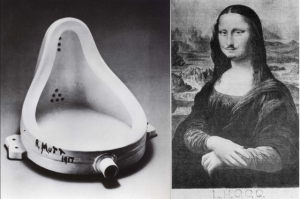
Can we create a definition, that defines art? NO! Most people will say, like Peter Selz, that there are no boundaries for art. When everything is possible – how can we give a clear and distinct definition of, what art is?
There is only one working theory and that is the institutional concept of art. If the art world gives its blessings. It’s art! So simple. This is a wonderful “dictator-theory” and the strength is, that its ready for all future changes. Favrholdt hated the “dictator-theory” because it shifts the view away from the art objects over to the power-hungry art institutions. The thing that makes an art object is no longer the art object itself, but all the fuzz around the art object. The “dictator-theory” is great at defining art but says nothing about the art objects. Favrholdt created a theory that is based on the art objects and leaves out the all-signifying art institutions. It´s a brave theory that tries to explain why some art is better than other kinds of art.
The system builder’s perspective:
[su_quote]Unfortunately, evolutionism has reached a point where it now dominates all of our art institutions. […] There is a difference between a more or less conscious search for new ways of expression, because you have grown tired of the existing ones, and making it mandatory for such new ways to be sought out.[/su_quote]
Favrholdt is a true system-builder! The starting point for his theory of art is that it’s based on the product, not the artist, historical context or any other paradigm. Loosely translated, Favrholdt says this about his theory:
In characterizing a work of art, you can identify different aspects that apply to it, which is commonly characteristic of any work of art. Sangild called it attractors. But these traits can occur in different levels of strength, and for this reason; I use the word parameter to accurately describe these traits. When you’re looking at art you can now ascribe a value to the different parameters. You’re giving an art object points like it’s a movie review or a restaurant.
Let’s jump to Favrholdt´s list of relevant parameters. There might be more parameters, but that´s another discussion. The following table shows what Favrholdt came up with – accompanied by a brief explanation:
| Integration |
Concerning: The interaction between the parts to form a whole. |
| Diversity and complexity |
Concerning: The set of elements, that come together in the artwork. |
| Technology |
Concerning: The technical skills that should be relatively invisible, and their consistency with the idea and personal expression of the artist. |
| Aesthetic beauty qualities |
Concerning: The aesthetic beauty of the artistic experience. |
| Individual embossing |
Concerning: The imprint of humanity, showing that the artwork has gone through a consciousness. |
| Repeatability |
Concerning: Artistic experiences that are equally good every time. |
| Intellectual appeal |
Concerning: The ideological content. |
| Emotional appeal |
Concerning: The emotional effects. |
| Other suggestive qualities |
Concerning. Ex. ugliness as an aesthetic instrument. |
| The Ineffable message |
Concerning: The ineffable message which by its very nature is transcending our common language. |
Favrholdt´s parameter theory is all about giving artworks grades on a scale from ex. 1-10. If we can give our children grades, we can surely give artworks grades. The artworks don’t need to score high in all parameters to be a great work of art. It would actually be very unlikely to score high in all parameters. But we would need the wisdom of the crowd to justify the points on the scale. Right, about 1024 people must have evaluated the artwork. This theory can´t work if it´s a single individual, professional or not – that does the evaluation. And the evaluation would still be subject to statistical uncertainty and trends. The last thing to do is to add the numbers and view the result:
Defining parameters: Location and time! If the art work is placed in a fancy gallery or museum it is most likely art. Time: If we, as a nation has viewed the work as art for a long period of time. It´s most likely art. Remember all evaluations of art are time-specific and not everlasting.
0-15 – Crappy art or a well-placed teacup. This score means that it’s not a great world defining the piece of art. We are all artist! You shall not pass, said Gandalf to this artwork!
16-20 – Some artistic quality but time will tell if it´s metaphysical destruction breaks through the cracks.
21-30 – Yes, but is it art? There is specific artistic quality here. If it scores high in some parameters it´s a great piece of art.
31-40 – A great idea! It would look great on my wall.
41-50 – Great art! No dought about it.
51-70 – The wow-factor is present and its abundantly clear that this is amazing art.
71-90 – Cthulhu will make a fart uttering in a thousand years of darkness. Thou this is really great art! This shit is the stuff of legends.
91-100 – The rapture is upon us. Save yourself! The Elder Gods will arise! The Call of Cthulhu will sound through the cracks of our fragile oblivion. This shit piece of artwork will charge your life forever.
Objectivism quickly turns into inter-subjectivism, but that is objective enough for me today. This system is hard to learn and it´s not always easy to remember all the parameters, but the great advantage of this system is that it forces you to think about the artwork from many different angles.
Abolish the dictator theory of art and give in to the Parameter Theory and the wisdom of the crowd. There will always be a degree of conflict in the great battle about what art is. BUT remember: It does not matter how old, famous or pricey the artwork is – the only thing that matters is: How it makes you feel!
A pragmatists view:
To judge whether a work of art is any good (objectively), ask the following questions about it to see how many can be answered with a yes:
-
Does it express successfully what it’s intending to express?
-
Does it amaze you in a different way each time you look at it?
-
Does it grow in stature?
-
Does it continually mature?
-
Does its visual impact of mysterious, pure power increase every day?
-
Is it unforgettable?
Good day to you, sir:-)
